

ORBITS AND MASSES OF THE SATELLITES OF HAUMEA. Our data analysis uses observations from various cameras on the Hubble Space Telescope (HST) and the NIRC2 camera with Laser Guide Star Adaptive Objects at the W.
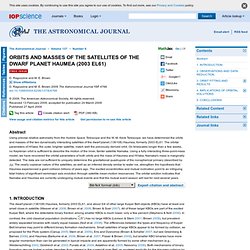
M. Keck Observatory. These observations are processed in different ways; here we describe the general technique and below we discuss the individual observations. Even on our relatively faint targets (V ≈ 21, 22), these powerful telescopes can achieve relative astrometry with a precision of a few milliarcseconds. The Julian Date of observation, the relative astrometric distance on-the-sky, and the estimated astrometric errors are reported in Table 1. Table 1. Notes. Observations from Keck are reduced as in B05. 009963 pixel−1 (compared to the previously assumed value of 0 009942 pixel−1) and an additional rotation of 0 13 compared with the rotation information provided in image headers. HST benefits from a known and stable point-spread function (PSF) and well-calibrated relative astrometry.
. ↑ Close. Strange Dwarf Planet Has Red Spot. A dwarf planet in our solar system, called Haumea, is known for its unusual shape and fast spin.

Now astronomers have discovered another distinguishing feature: a dark red spot which appears to be richer in minerals and organic compounds than the surrounding icy surface. Haumea, discovered in 2004, orbits the Sun beyond Neptune, in a region known as the Kuiper Belt. It is classified as a dwarf planet ? A celestial body that is big enough to have been rounded by its own gravity, but has not cleared its neighboring region of similar objects. There are four other dwarf planets: Ceres, Pluto, Eris and Makemake. Dwarf planet's body parts litter outer solar system - space - 15 October 2008. The dwarf planet Haumea appears to have led a very violent life.
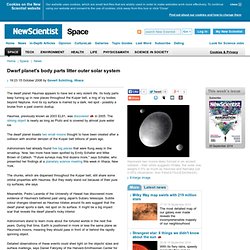
Its body parts keep turning up in new places throughout the Kuiper belt, a ring of icy bodies beyond Neptune. And its icy surface is marred by a dark, red spot - possibly a bruise from a past cosmic dustup. Haumea, previously known as 2003 EL61, was discovered in 2005. The oblong object is nearly as long as Pluto and is covered by almost pure water ice. The dwarf planet boasts two small moons thought to have been created after a collision with another denizen of the Kuiper belt billions of years ago. Astronomers had already found five big pieces that were flung away in the smashup. Dwarf Planet Veiled in Water-Ice. Bizarre Dwarf Planet Haumea Wrapped in Water Ice. Radioactivity and gravity may be why the strange football-shaped dwarf planet known as Haumea and its moons are unexpectedly sheathed in crystalline ice, shining in space, researchers suggest.
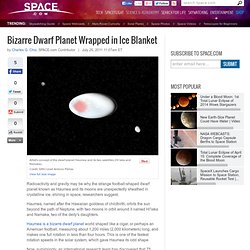
Haumea, named after the Hawaiian goddess of childbirth, orbits the sun beyond the path of Neptune, with two moons in orbit around it named Hi'iaka and Namaka, two of the deity's daughters. Haumea is a bizarre dwarf planet world shaped like a cigar, or perhaps an American football, measuring about 1,200 miles (2,000 kilometers) long, and makes one full rotation in less than four hours. Small World Beyond Neptune Covered in Ice. A small space rock that orbits the sun from out beyond Neptune is almost completely coated in water ice, according to a new study that allowed astronomers ?
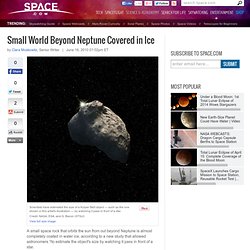
To estimate the object's size by watching it pass in front of a star. The icy, rock body ? Dubbed KBO 55636 ? Lies in an outer region of our solar system called the Kuiper Belt, which contains at least 70,000 small bodies orbiting farther than Neptune. The region extends out to roughly 70 times the distance between the sun and Earth. Learning details about these objects is generally difficult because they are relatively small, distant and dim. Haumeia:curious dwarf planet in the Kuiper belt. Haumea is one of the strangest known objects in the solar system.
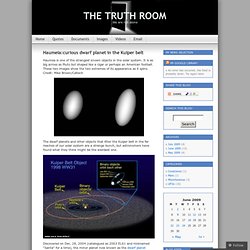
It is as big across as Pluto but shaped like a cigar or perhaps an American football. These two images show the two extremes of its appearance as it spins. Credit: Mike Brown/Caltech The dwarf planets and other objects that litter the Kuiper belt in the far reaches of our solar system are a strange bunch, but astronomers have found what they think might be the weirdest one. Haumea. The strangest known object in the Kuiper belt 2003 EL61 -- now known as Haumea -- is one of the strangest known objects in the solar system.
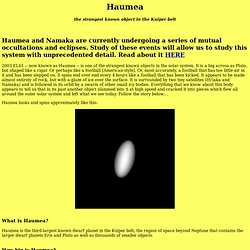
It is a big across as Pluto, but shaped like a cigar. Or perhaps like a football [American-style]. Or, most accurately, a football that has too little air in it and has been stepped on. It spins end over end every 4 hours like a football that has been kicked. Haunea looks and spins approximately like this: Dwarf Planets: Haumea. Oddly-shaped Haumea is one of the fastest rotating large objects in our solar system.
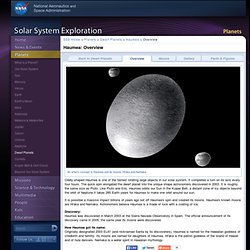
It completes a turn on its axis every four hours. The quick spin elongated the dwarf planet into the unique shape astronomers discovered in 2003. It is roughly the same size as Pluto. Like Pluto and Eris, Haumea orbits our Sun in the Kuiper Belt, a distant zone of icy objects beyond the orbit of Neptune.It takes 285 Earth years for Haumea to make one orbit around our sun.
It is possible a massive impact billions of years ago set off Haumea's spin and created its moons. Haumea: The Divine Midwife. “Haumea, a Polynesian Goddess, was credited with teaching women how to give birth by pushing their babies out from between their legs. Before this, folklore claims that children were cut from their wombs, extracted by knife like a pit from ripe fruit. Thanks to Haumea, women were able to forgo this dangerous passage.” –Kris Waldherr, Goddess Inspiration Cards Reading this, I felt like women need to “meet” Haumea again. Perhaps modern midwives, doulas, and birth educators are Haumeas on earth, reminding women that they have the inherent power and capacity to push their own babies out from between their legs, rather than having major surgery. After reading about Haumea and thinking about my own births, I felt inspired to make yet another figure in my birth art series.
You will safely give birth to something powerful. Haumea & Makemake: the Astronomy and Astrology. Copyright © 2008-2009 Nick Anthony Fiorenza, All Rights Reserved Extensive new material on Haumea & entirely new material on Makemake added March 21, 2009 Introduction to Haumea & Makemake Due to the similar orbits of Haumea and Makemake, I discuss them together on this web page.

Haumea (pronounced how-MAY-ah), the third-largest known dwarf planet in the Kuiper belt (at the time of discovery) was discovered on Dec 28, 2004 by Mike Brown; et.al. of CalTech using the Keck Observatory in Hawaii. Makemake (pronounced MAH-keh MAH-keh - "e" is pronounced "ay" in Polynesian), of similar size, was discovered on March 31, 2005 also by Mike Brown. Paisagem_lua_Haumea_texturizado.